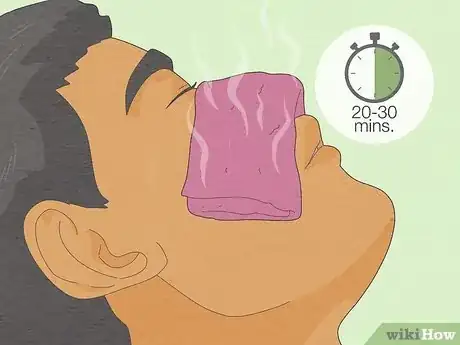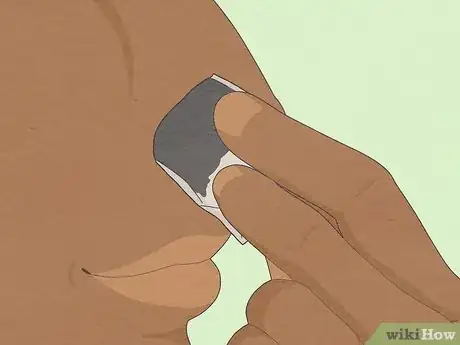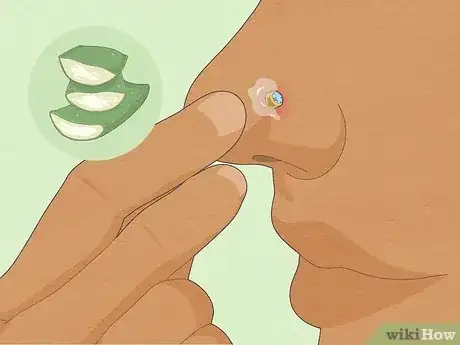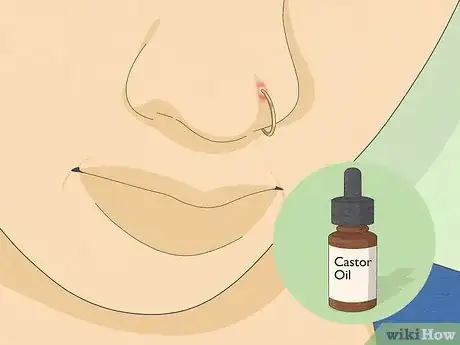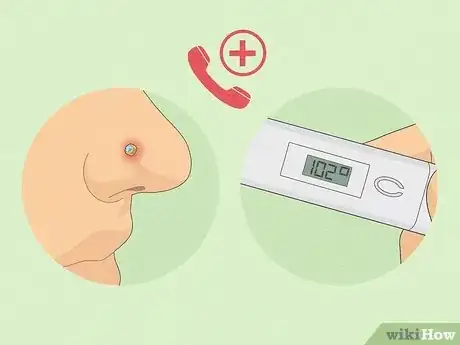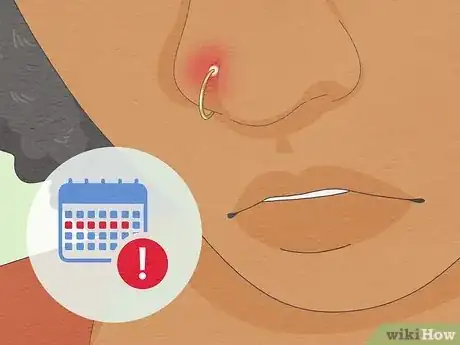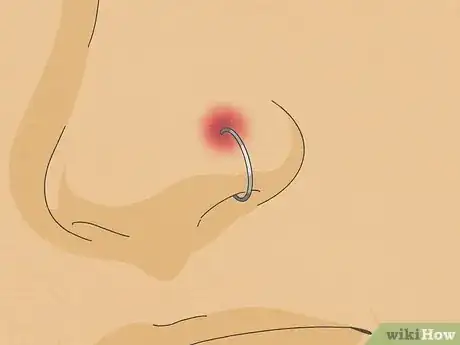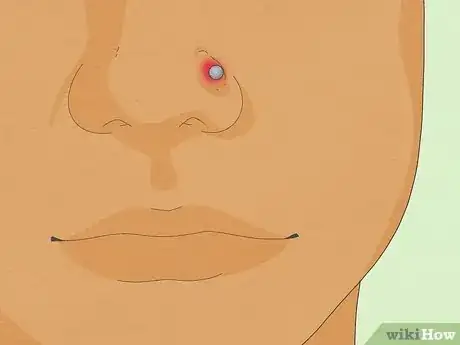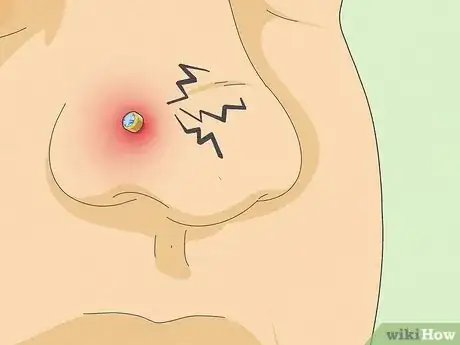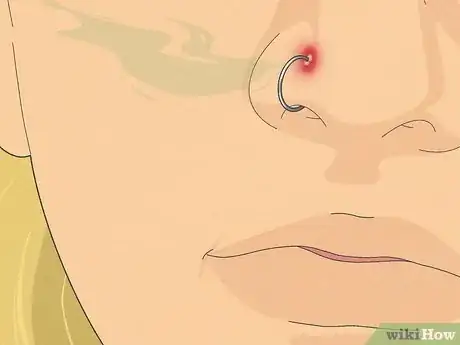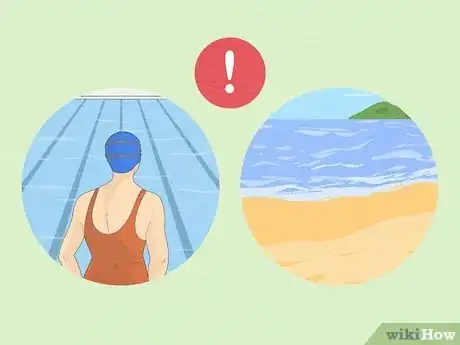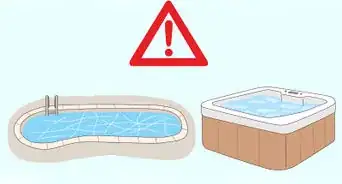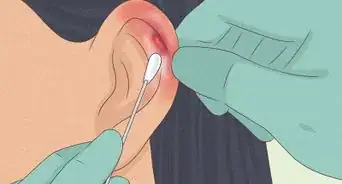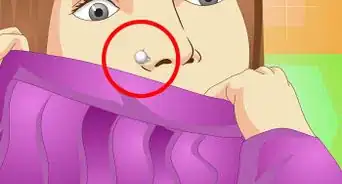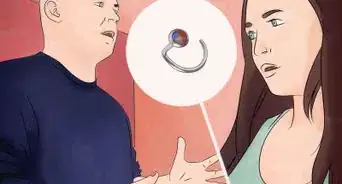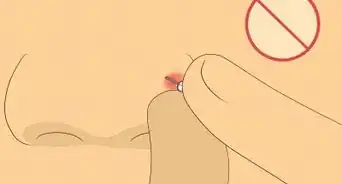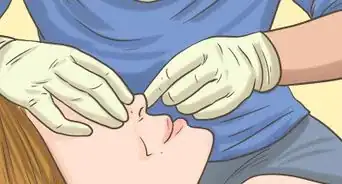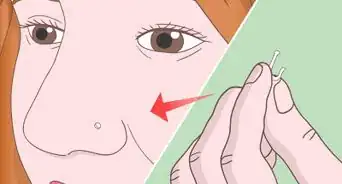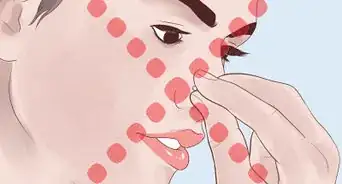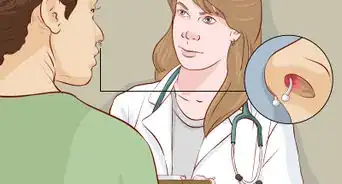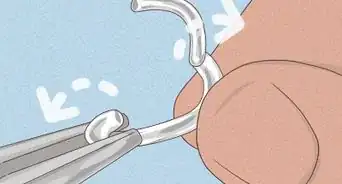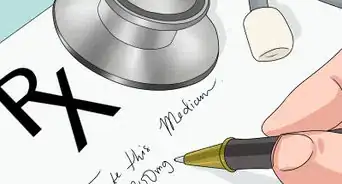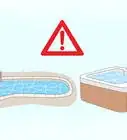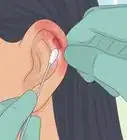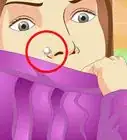This article was medically reviewed by Karissa Sanford and by wikiHow staff writer, Jennifer Mueller, JD. Karissa Sanford is the Co-owner of Make Me Holey Body Piercing, a piercing studio based in the San Francisco Bay Area that specializes in safe and friendly body piercing. Karissa has over 10 years of piercing experience and is a member of the Association of Professional Piercers (APP).
There are 13 references cited in this article, which can be found at the bottom of the page.
wikiHow marks an article as reader-approved once it receives enough positive feedback. This article has 13 testimonials from our readers, earning it our reader-approved status.
This article has been viewed 2,308,248 times.
It can be frustrating when your new nose piercing seems to take forever to heal—but it's even worse when you start worrying it's become infected. Fortunately, a mild infection is pretty easy to treat at home. With the proper care, you'll start noticing a big difference in a week or two. Read on to learn how to clear an infection on your own, as well as when you need to call your doctor.
Things You Should Know
- Clean your infected piercing 3-4 times a day with a sea salt solution and gently pat it dry.
- Soak a clean cloth in warm water and hold it on the piercing for 20 to 30 minutes to increase blood flow and speed up the healing process. A chamomile tea bag is also soothing.
- Dab aloe vera gel around the piercing for immediate relief from pain, swelling, and inflammation.
- See your doctor if you have severe pain or a fever so they can prescribe an antibiotic to clear the infection.
Steps
Expert Q&A
-
QuestionSo I've had a piercing for months and I clean it regularly. After a while, I removed it and haven't used it since. It has been 2-3 years and I have a little bump. The piercing hole is definitely closed. is there a way to treat this to make the bump disappear even after I haven't used the piercing for a couple of years ?
 Luba Lee, FNP-BC, MSLuba Lee, FNP-BC is a Board-Certified Family Nurse Practitioner (FNP) and educator in Tennessee with over a decade of clinical experience. Luba has certifications in Pediatric Advanced Life Support (PALS), Emergency Medicine, Advanced Cardiac Life Support (ACLS), Team Building, and Critical Care Nursing. She received her Master of Science in Nursing (MSN) from the University of Tennessee in 2006.
Luba Lee, FNP-BC, MSLuba Lee, FNP-BC is a Board-Certified Family Nurse Practitioner (FNP) and educator in Tennessee with over a decade of clinical experience. Luba has certifications in Pediatric Advanced Life Support (PALS), Emergency Medicine, Advanced Cardiac Life Support (ACLS), Team Building, and Critical Care Nursing. She received her Master of Science in Nursing (MSN) from the University of Tennessee in 2006.
Board-Certified Family Nurse Practitioner It sounds like the bump you are describing is a scar tissue and it might get slightly smaller over time, but it is unlikely that it will ever disappear.
It sounds like the bump you are describing is a scar tissue and it might get slightly smaller over time, but it is unlikely that it will ever disappear. -
QuestionCan I use table salt for the salt solution, as I do not have sea salt?
 Luba Lee, FNP-BC, MSLuba Lee, FNP-BC is a Board-Certified Family Nurse Practitioner (FNP) and educator in Tennessee with over a decade of clinical experience. Luba has certifications in Pediatric Advanced Life Support (PALS), Emergency Medicine, Advanced Cardiac Life Support (ACLS), Team Building, and Critical Care Nursing. She received her Master of Science in Nursing (MSN) from the University of Tennessee in 2006.
Luba Lee, FNP-BC, MSLuba Lee, FNP-BC is a Board-Certified Family Nurse Practitioner (FNP) and educator in Tennessee with over a decade of clinical experience. Luba has certifications in Pediatric Advanced Life Support (PALS), Emergency Medicine, Advanced Cardiac Life Support (ACLS), Team Building, and Critical Care Nursing. She received her Master of Science in Nursing (MSN) from the University of Tennessee in 2006.
Board-Certified Family Nurse Practitioner Table salt has iodine which might be too irritating to some people compared to iodine-free salt.
Table salt has iodine which might be too irritating to some people compared to iodine-free salt.
Warnings
- Never remove the jewelry from an infected piercing unless a doctor tells you to do so. Nose piercings can close up in a matter of hours if they aren't fully healed.[26]⧼thumbs_response⧽
- Never use rubbing alcohol or hydrogen peroxide on your piercing unless a doctor tells you to do so. They're too harsh and make it harder for skin to heal.[27]⧼thumbs_response⧽
References
- ↑ https://www.mayoclinic.org/ear-piercing-infection/expert-answers/faq-20452841
- ↑ https://uhs.berkeley.edu/health-topics/body-piercings
- ↑ https://www.drugs.com/cg/pierced-earlobe-infection-aftercare-instructions.html
- ↑ https://www.drugs.com/cg/pierced-earlobe-infection-aftercare-instructions.html
- ↑ http://www.sinonskin.co.uk/piercing-faq-s.html
- ↑ https://www.ncbi.nlm.nih.gov/pmc/articles/PMC2763764/
- ↑ https://www.ncbi.nlm.nih.gov/pmc/articles/PMC3418662/
- ↑ https://www.ncbi.nlm.nih.gov/books/NBK537336/
- ↑ https://uhs.berkeley.edu/health-topics/body-piercings
- ↑ https://myhealth.alberta.ca/Health/aftercareinformation/pages/conditions.aspx?hwid=abk1292
- ↑ https://www.nhs.uk/conditions/infected-piercings/#Self-care
- ↑ https://myhealth.alberta.ca/Health/aftercareinformation/pages/conditions.aspx?hwid=abk1292
- ↑ https://www.ncbi.nlm.nih.gov/books/NBK537336/
- ↑ https://www.ncbi.nlm.nih.gov/books/NBK537336/
- ↑ https://www.nhs.uk/common-health-questions/lifestyle/can-i-go-swimming-after-a-piercing/
- ↑ https://www.nhs.uk/conditions/infected-piercings/#Self-care
- ↑ https://www.nhs.uk/common-health-questions/lifestyle/can-i-go-swimming-after-a-piercing/
- ↑ https://www.ncbi.nlm.nih.gov/books/NBK537336/
- ↑ https://www.mayoclinic.org/healthy-lifestyle/adult-health/in-depth/piercings/art-20047317?pg=2
- ↑ https://youngwomenshealth.org/guides/body-piercing/
- ↑ https://www.mayoclinic.org/healthy-lifestyle/adult-health/in-depth/piercings/art-20047317?pg=2
- ↑ https://uhs.berkeley.edu/health-topics/body-piercings
- ↑ https://www.mayoclinic.org/healthy-lifestyle/adult-health/in-depth/piercings/art-20047317?pg=2
- ↑ https://dermnetnz.org/topics/jewellery-allergy
- ↑ https://youngwomenshealth.org/guides/body-piercing/
- ↑ https://uhs.berkeley.edu/health-topics/body-piercings
- ↑ https://uhs.berkeley.edu/health-topics/body-piercings
About This Article
If you notice symptoms, like fever, redness, or tenderness, you may have an infected nose piercing and need to visit your doctor. To treat your infection at home, apply a warm compress to your nose with gentle pressure, so it can relieve some of the swelling. You should also make sure to remove any dried pieces of skin or debris from around the area, as well as wipe away any discharge you notice. As long as your nose piercing is infected, you should wash the area 3 or 4 times a day with either soap and warm water or a sea salt solution, which can serve as a natural antiseptic. Because nose piercings close very quickly, do not remove your piercing unless your doctor recommends it, or your nose could develop an abscess. For more tips from our Medical co-author, including how to prevent your nose piercing from becoming infected, keep reading!


